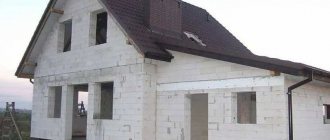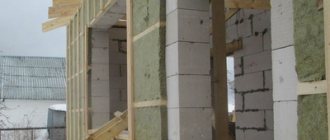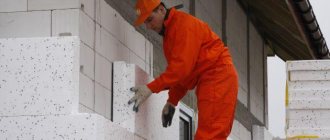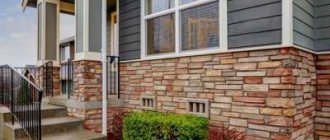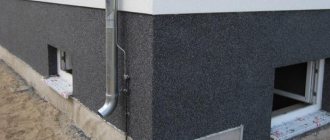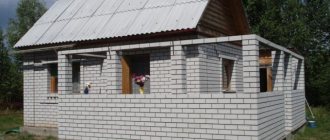Houses made of foam concrete without finishing have an unpresentable appearance. But it is much more important that foam blocks absorb moisture well. Therefore, it is impossible to do without facade work. One of the common solutions is plaster. But keep in mind that the technology for plastering foam blocks on the outside differs from similar work on brick and other stone materials. If you miss a number of points, you won’t be able to get a durable and beautiful façade coating. There are certain nuances already at the stage of choosing materials; you should familiarize yourself with the main ones.
How the type of block affects the choice of plaster
Foam concrete blocks, according to the manufacturing method, can be divided into two types.
- Molded. Manufactured by pouring foam concrete into molds. They are distinguished by a darker color and the presence of chips. There are residues of lubricants on the surface that were used to pre-treat the cassettes. A smooth top layer and the presence of oil stains impair adhesion to the plaster, so preliminary preparation of the wall is required before finishing.
- Sawing machines. Obtained by cutting pre-filled large blocks. They are distinguished by their correct geometric shape, absence of defects, and rough surface. On walls made of such foam blocks, plaster holds up better.
There are more molded blocks on sale. Due to their lower price, they are in constant demand. But, given the low adhesion, they can only be plastered using special mixtures and compositions.
Sawn foam blocks, theoretically, can be finished with standard cement mortar, but after preliminary surface preparation.
Features of the building material
Cellular concrete blocks are popular in the field of low-rise construction due to their high performance characteristics:
Along with a set of advantages, the material has serious disadvantages:
To increase adhesion, the following measures are taken:
Kawabanga! Foam concrete blocks - characteristics of their advantages, disadvantages, selection criteria and tips for use
Due to its porous structure, foam concrete needs additional protection.
Selecting consumables
For preparatory work and for plastering the outside of a house made of foam blocks, we will need the following materials:
- concrete contact or deep penetration primer to strengthen the outer layer and improve adhesion;
- plaster mesh made of fiberglass (galvanized steel can be used, but this option will be more expensive);
- standard beacons that allow you to obtain a flat surface;
- plaster mixtures for external use, intended for foam and aerated concrete, and other cellular blocks.
Good results are obtained by using mixtures of Ceresit, Belsilk, Caverplix. Others with increased adhesion and frost resistance are also suitable.
In order to save money, homemade plaster for foam blocks (external) is also used. It is based on a mixture of cement, sand and lime. Keep in mind that such a solution is incomparable in its performance to professional formulations that contain polymer components.
Working with lime plaster is more difficult, so if you have no experience, it is better to abandon this option in favor of factory-made materials.
Combating poor adhesion
Foam block is a rather capricious thing regarding plaster compositions. Not every sand-cement mixture mixed in a duty trough is suitable for high-quality finishing. The mass may simply fall off, especially if there are sufficiently large deviations vertically or horizontally and there is a need to level the surface with a thick layer of more than 5 cm. There are two excellent, relatively inexpensive ways to increase surface adhesion (the ability to hold the plaster composition due to the mutual penetration of materials into each other). Coating with foam concrete surfaces with primers, concrete contacts and other special compounds. Construction of reinforcing mesh.
Both a special plaster mesh purchased at a construction market and a nylon fishing net with cells no larger than 5-6 cm are suitable as reinforcement. In the absence of surface preparation using the above methods, you can follow the path of “layering” the plaster, and carry out it in three stages: spraying with liquid layer, applying the base layer and covering. Between stages, there must be enough time for the previous layer to dry completely. Before applying plaster directly to the foam concrete blocks, you must first moisten the surface. It is advisable to use a spray bottle for this in order to achieve widespread penetration of water into the cellular structure of the wall material.
List of tools
To prepare the wall and subsequent plastering of foam blocks outside the house, you will need the following tools:
- brushes or roller for applying primer;
- drill with a mixing attachment for preparing the solution;
- spatula, trowel for spreading and leveling plaster;
- level, tape measure for correct installation of beacons;
- knife for cutting plaster mesh:
- usually a grater to level the finishing layer.
This kit is enough for all operations on external plastering of buildings made of foam blocks.
Installation of fiberglass sheeting
Having figured out how to fix the meth. mesh for plaster, we will easily understand how to attach a plastic mesh. The fiberglass panel bends easily and weighs little. Therefore, it is easier to attach it to the wall. Usually they do this with self-tapping screws only along the top edge, lowering the “fabric” from top to bottom like wallpaper. The entire panel “sticks” to the wall using plaster mortar.
Using a solution, the network is attached to the base, doing this:
- Apply a layer of plaster composition to the surface. The width of the applied layer is equal to the width of the mesh. The composition is applied with a trowel (50 cm) or a wide spatula.
- The canvas is unwound and applied to the upper edge of the wall with its end. The remaining part of the canvas is lowered down.
- The panel is straightened so that its edge runs parallel to the corner line. Craftsmen often place the edge on the surface of the adjacent wall (3 cm).
- Using a wide spatula or trowel, finally leveling, the net is embedded in the layer of solution. The plaster mixture appears through the meshes above the network and is immediately leveled with the same tool.
- Allow the reinforced plaster to dry, after which the following finishing work is carried out according to plan.
Preparation of external walls
One of the main stages affecting the quality and durability of the future facade.
In addition to the main task - to ensure good adhesion of the plaster to the wall, there is another, very significant one - to save money.
How to make sure that the plaster adheres firmly to the wall will be discussed below.
And now about how to save money. Actually, you need to think about savings when plastering walls when constructing these same walls. If they are laid out unevenly, then the situation will have to be corrected with quantity. We install the beacons and plaster them in several layers, hiding unevenness and leveling the horizontal. Therefore, in order for the plastering of foam blocks on the outside to be done with a minimum amount of mixture, the first step is to achieve the most even walls possible when laying.
There is, however, one life hack. In cases where the wall is bumpy here and there, it may be easier not to add layers of plaster, but to remove the protruding areas.
How? Foam block lends itself well to processing. Therefore, protruding areas can be trimmed with a special grater for foam blocks.
Using the same grater, we remove all oiliness and other complex contaminants that impair adhesion.
How to properly plaster walls made of foam blocks, what reinforcing mesh to use
Question No. 66: Inside the house, walls made of foam block and brick must be plastered. What mesh should be used if builders want to make a cement-sand mortar for plaster (Boris Answer: I would like to know the qualifications of your builders and their knowledge in the field of finishing work on walls made of aerated concrete, foam concrete and other types of materials made from lightweight concrete mixtures. Did they explain to you what they were basing on when they suggested you plaster walls made of foam blocks with sand-cement mortar? There are no questions about brick walls, where the use of PC mortar as plaster is acceptable. If this is only related to the price material, then I do not advise you to agree to this.
Walls made of foam blocks have one not very good ability that occurs when they are plastered, they absorb moisture very quickly. The layer of plaster, without having time to harden, immediately becomes dry and crumbles, it may not crumble immediately, but after three or four days after the builders receive the money from you, they will simply disappear.
Therefore, a special lightweight plaster mixture with high adhesive properties has been developed for walls made of foam blocks. The manufacturer labels it as follows: “For foam concrete.” Before applying it to the foam concrete wall, the surface is pre-treated with a deeply penetrating primer.
If you have not yet lost the desire to plaster foam concrete with cement-sand mortar, then you can try to do it, but you must follow the entire technological chain correctly and prevent the formation of cracks in the plaster or its peeling off altogether.
I have already said that in this case, when using a CP solution, it is necessary to solve the main problem when plastering - the instant absorption of moisture by foam concrete blocks. The time required for plastering will be much longer than when using a special plaster mixture.
We solve this problem in the following way: we prepare a very liquid CP solution and spray it on the wall from foam blocks, you can do it manually using a special machine used for façade “fur coats”. After making sure that the adhesion to the blocks is strong enough and the mass has not completely dried, we put a plaster mesh (not metal!) made of fiberglass (serpyanka) on the wall and apply the main layer of plaster. In this case, the “spray” acts as a primer and therefore ensures high-quality adhesion of the plaster to the foam blocks.
If you have sawn blocks, then the mesh must be used over the entire surface of the walls, and if cast, then the reinforcing mesh can be used only in those critical areas where there is always an increased concentration of stress at the joints of the masonry: corners, doorways, junctions with floor slabs, windows.
As for plastering a brick wall, both fiberglass and metal reinforcing mesh can be used as a reinforcing mesh. Cement-sand mortar is applied to the wall in the same way as on blocks in two layers. Only the first layer can be applied simply with a spatula, then press the reinforced mesh into it and then apply the main layer of plaster. Good luck. After all the finishing work, the question often arises of how to arrange the interior space of the room. Experts advise installing sliding partitions www.keyform.ru/razdvizperegorodki, which save a lot of space and give the room a stylish European design.
Source
Dew point determination
Dew point is the temperature at which water vapor begins to condense. If it ends up on the surface from the side of the room, wet spots, mold, and mildew will begin to appear. Therefore, it is necessary to calculate the ratio of the thickness of all coatings so as to shift the dew point outward.
Very often, the plaster coating differs from the foam blocks in the coefficient of vapor permeability (and to a lesser extent), therefore, when finishing on both sides of the wall, it is necessary to ensure such a thickness of layers so that less water vapor comes from the room than can be discharged outside.
Practical experience in construction from cellular blocks has shown that this result can be obtained when the external plaster is 2 times thinner than the internal one.
Installation of plaster mesh to the ceiling
When working on ceilings, fastening the plaster mesh is carried out similarly to fastening on walls, with some differences. This is due to the difference in the performance of ceiling and wall plaster coatings. On the walls, the peeling coating rests on the underlying areas, but on the ceiling it works to break, holding onto the adjacent areas with its edges. Therefore, fixing the mesh under the plaster is done more thoroughly.
For example, for a metal reinforcing mesh, more fixation points are required, their spacing and arrangement in a row are ordered. Nails (or self-tapping screws) are placed along the row at a distance of 20-30 cm. A step of 20-30 cm is maintained between the rows. In adjacent rows, the nails are offset by 10-15 cm (a checkerboard arrangement is obtained). After filling the nails with the mesh, the fabric is stretched and attached (without sagging).
There must be a certain distance between the mesh wires (fiberglass) and the surface of the ceiling material, which is filled tightly with mortar during plastering. The reinforced mesh is installed so that it runs through the middle of the thickness of the plaster layer.
Work order
Plastering of foam blocks on the outside is carried out during the warm season. There is no need to complicate the process and increase the risks by working at sub-zero temperatures.
The façade was cleared of dirt and dust. Freed up space around the house for quick assembly and movement of scaffolding when working at height.
The whole process can be divided into several stages.
Leveling with primer
The primer allows you to cover minor defects in the foam block during multi-layer application. But this, of course, is not its main task. The primer is necessary to strengthen the base and improve adhesion to the base plaster. To obtain the desired effect, only deep penetration compositions based on silicate are used.
We prime with a roller or a large brush in 3 layers, making sure to dry each one. After the first pass, the outer part of the foam concrete is strengthened, and the rest increase adhesion.
Fastening the plaster mesh
The use of plaster mesh is due to the need to increase the strength of the finishing layer and prevent the mortar from sliding off the wall. Without such reinforcement, the coating will begin to crack within the next 3-4 months.
To plaster the outside of a house made of foam blocks, we choose a fiberglass mesh that is resistant to the effects of alkaline chemical compounds that are part of the plaster mixtures. It is possible to mount it with self-tapping screws, which can be easily screwed into the block, or with glue (for tiles).
During installation, it should be taken into account that there must be a gap of at least 2-3 mm between the mesh and the wall. The material cannot be pressed tightly to the surface, otherwise it will not perform its reinforcing functions.
Installation of auxiliary beacons
We install the beacons strictly vertically, checking the position with a building level. To simplify the work, we mount the outer elements, after the glue has hardened, we stretch nylon threads between them every 50-70 cm. The installation of the remaining beacons can be done without a level, guided by the control threads.
We choose the distance between individual elements taking into account the length of the rule, but it is better if it does not exceed 1.2-1.5 m. This makes it more convenient to work and easier to ensure quality.
Application of the solution
At the first stage, the plaster mixture is applied so that the reinforcing mesh is completely hidden. We work with a trowel or a suitable ladle. Here, choose for yourself what is more convenient for you.
Then we level it with a spatula so that the coating does not protrude beyond the beacons.
We begin further work only after the composition has set, otherwise the too thick layer will slide off.
Final grout
After adding the finishing layer, we level the wall using a rule, which we move while pressing tightly against the beacons. At the same time, we remove excess mortar, and re-fill and level the areas with holes.
The result is a flat surface. If there are small defects, remove them with a grater. This work is easier to do before the composition has completely hardened.
We putty the leveled surfaces for painting or apply decorative plaster.
Nuances of technology
Be sure to observe the temperature regime! A cold surface is not suitable, and for both external and internal finishing it is required that the walls have their own temperature not lower than +5℃, but not heated above +30℃. You should also pay attention to the absolute humidity of the surface: dry cellular concrete absorbs water almost instantly, which has a very negative effect on the drying process of the plaster layer and the correct development of strength. It is generally advisable to forcibly moisten the surface using spray bottles before applying the plaster.
It is imperative to prepare the surface for applying plaster, as mentioned above.
If you are not using mesh, be sure to prime the blocks. Actually, even if there is reinforcement, a primer will not be superfluous. Before applying the primer, all dirt stains, especially oil stains, should be removed.
Additionally, pay attention to the following subtleties of the technology for plastering foam blocks:
- Reinforcing fiberglass mesh allows you to avoid cracking of the plaster at joints and in seams with an opening of more than 5 mm on old masonry. The mesh is recessed into the layer of plaster to a depth of 2/3 of its total thickness; if the wall is uneven with vertical deviations of more than 1 cm, it is preferable to install beacons for better “pulling” in level; finishing procedures for grouting the covering layer should be carried out only after waiting for complete drying .
Possible problems
When plastering foam blocks outside the house, the following difficulties may arise:
- The solution does not stay on the wall surface and rolls down.
- Cracks appear on the hardening plaster.
- It is not possible to sketch a layer of the required thickness.
In order to avoid these problems, we use strictly suitable building mixtures in the correct proportions. According to the rules, we also attach the reinforcing mesh, and before that we carefully prepare and treat the wall.
Well, it’s better to plaster in a large number of layers, but thinner. This will reduce the mass of the thrown composition and prevent its spontaneous displacement under its own weight.
How to plaster foam blocks from the outside is described in some detail in the video below. The person is inexperienced and does not work quickly, but it turned out well.
How to attach metal mesh
The main task at the reinforcement stage is not only to securely fix, but also to straighten the mesh fabric. Metal products are usually heavy and elastic. Therefore, in order to reliably fix the panel on a wall or ceiling, you need a sufficient number of fastening points, and the fastening elements themselves must withstand the weight of the network (taking into account the weight of a thick layer of mortar that tends to slide down along the surface).
The design of the fixing part is selected taking into account the cell size. The cells of metal sheets are larger than those of plastic ones.
Probably the easiest option for wooden and brick walls is to nail the canvas. In this case, the nails are driven in only partially (hardware 60-70 mm long are driven in 50 mm), and the upper part of the nail is bent, pressing the mesh fabric to the base. In a brick base, nails are driven into the masonry seam. There are no specific recommendations on the spacing of attachment points or their placement on the plane. However, it is recommended to fasten the upper edge of the canvas in increments of up to 50 cm (optimally 25 cm) parallel to the corner line.
An alternative to nails is self-tapping screws. You can use them on any surface except metal. However, to install self-tapping screws in concrete, you will need dowels. The diameter of the screw head is not enough to securely press the net. That's why washers are used.
You can make the clamping parts yourself. A mounting tape perforated in length is suitable for our purpose. We also attach the mesh under the plaster using metal hangers that are made for attaching drywall sheets. Using metal scissors, we cut the tape into pieces with two holes to create mounting strips that simultaneously press two mesh wires.
You can also tie a network to the caps of the self-tapping screws using a binding wire. First, screw in the self-tapping screw (without screwing it all the way), then, after attaching the wire, deepen it until it stops. From time immemorial, stove makers laid the ends of the binding wire into the masonry, and fixed the net with the leads. You can do this even now if you lay brick walls with your own hands.
Conclusion
External plastering of a house made of foam blocks is a traditional technology for finishing facades. In the case of foam concrete walls, the main problem is the low adhesive properties of the surface. Therefore, special attention must be paid to the selection of materials appropriate for the base and compliance with all technological requirements for the work process.
Do-it-yourself plastering of foam blocks outside the house is not the easiest process, but it can be done if desired.
When looking for simpler solutions, you should pay attention to ventilated facades.
Manual and mechanized plastering of foam blocks
The technology of manual plastering is discussed above. But it takes a lot of time and effort. Therefore, it is better to use mechanized application of plaster, especially for buildings with a large wall area.
The undeniable advantages of this technology include:
- automated application;
- reducing the number of plasterers hired;
- reduction of work completion time;
- saving materials;
- increasing the efficiency and quality of work.
Rice.
6. Plastering foam concrete blocks The machine independently prepares the solution and applies it. Therefore, up to 45 m2 of plaster is applied per shift (in manual mode, up to 7 m2).
Do I need to plaster the foam block?
Foam block is a representative of cellular concrete. It is warm, lightweight and has excellent soundproofing properties. In addition, standard dimensions allow the construction of structures that are perfectly even in geometry. In this regard, some believe that finishing of foam blocks is not required
However, there are several reasons why this work is important:
- Since foam concrete has cells, moisture can penetrate into them. This leads to an increase in the weight of the overall structure and additional load on the foundation.
- Walls and foundations may crack.
- Foam blocks without proper protection will begin to collapse.
- The durability of the structure is lost.
If you take the time, money and effort to plaster a room, you can achieve its protection from temperature changes and negative street factors, such as wind, precipitation, and UV rays. And the plaster itself will additionally serve as heat and sound insulation, as well as a decorative layer, decorating the facade.
What is a foam block
The light and warm material includes three main components - Portland cement, sand and foam obtained from rosin or protein. Inexpensive components and low-cost manufacturing technology make foam blocks an ideal material for the rapid construction of buildings that will last for decades.
Foam block is one of the most popular building materials today.
Methods for making foam blocks:
- Sawing. The foam is mixed with cement and sand and poured into a large container to harden. After the drying process, the resulting volume is sawn into standard products, which are distinguished by their correct geometry without chips or gouges.
- Liteva. It is produced by pouring the mixture into molds corresponding to the size of the products. After hardening, they are not cut and are ready for construction. Such blocks are rougher and rarely have the correct geometry.
Foam block, due to its structure, is an excellent heat-insulating and sound-proofing material from which houses are built in all regions of Russia, but the porous surface needs protection and without it the building material begins to quickly deteriorate.


